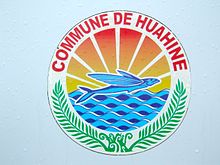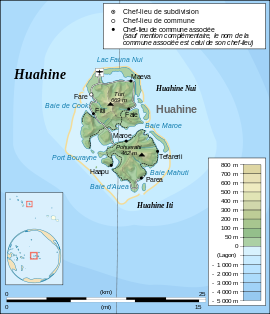|
Huahine
Huahine is an island located among the Society Islands, in French Polynesia, an overseas territory of France in the South Pacific Ocean. It is part of the Leeward Islands group (Îles sous le Vent). At the 2022 census it had a population of 6,263.[2] HistoryHuman presence on Huahine dates back to at least a millennium ago, as evinced by the numerous Marae on the island. Archaeologists estimate that the ancient Tahitian Maʻohi people colonized Huahine from at least the 9th century AD.[3] Huahine is home to one of the largest concentrations of Polynesian archaeological remains dated between 850 AD and 1100 AD. Independent kingdomUntil the late 19th century Huahine was an independent kingdom, also called the Huahine and Maiao Kingdom. According to tradition, three main dynasties succeeded each other: The Hau-moʻo-rere dynasty was founded in the 17th century; its last representative was Queen Tehaʻapapa I, whom Captain Cook met in 1769. She maintained the cohesion and independence of her kingdom. The Tamatoa dynasty has its origin in Tehaʻapapa I and her husband Mato a Tamatoa, member of the Tamatoa family of Raiatea. They were the founders of the Tamatoa branch of Huahine. This dynasty reigned until 1854. The Teururaʻi dynasty descends from Ariʻimate Teururaʻi, a Huahine chief, and his wife Teriʻiteporouaraʻi Tamatoa, member of the Tamatoa family of Raiatea, great-granddaughter of Queen Tehaʻapapa I of Huahine. This dynasty reigned from 1854 to 1895. The Polynesian prince Teriifaʻatau Marama could lay claim to the thrones of Huahine and Raiatea at the same time. However, the union of these two thrones under one scepter was unacceptable to both kingdoms so it was agreed that his younger brother would inherit the throne of Raiatea. In 1884, Teriifaʻatau Marama obtained the position of prime minister, a post previously held by his younger brother, who had become King that year. Teriifaʻatau Marama became a principle figure in the annexation of the kingdom of Huahine and Maiao by France. It was in 1895 that the regent, on behalf of Queen Tehaapapa, and the principal chiefs of the kingdom fully renounced their powers and privileges in favor of France, in a treaty of abdication dated 15 September of that year. After the annexation he was elected chief of Tefarerii, a position he held until his death. European exploration and colonizationThe name Huahine literally means "woman's sex". It could probably be translated as "pregnant woman" since the profile of Mount Tavaiura makes one think of a pregnant woman lying down.  Captain James Cook arrived in Fare Harbour on 16 July 1769, with Tupaia navigating HMS Endeavour. They met with leading chief Ori (Mato). Cook returned on 3 September 1773 and met with Ori's son Teriʻitaria, the new ariʻi rahi of the island.[4] Missionary Auna served as a deacon on Huahine prior to his work in Hawaii.[5] The Spaniard Domingo Bonaechea in 1775, called the island "La Hermosa" (The Beautiful).[6][7] Today it is known by the nickname "the island of the woman". In 1846 the island successfully resisted French rule,[8] the inhabitants never resigned themselves to the idea of being colonized and in 1847 the island proclaimed itself an independent state under the name of the Kingdom of Huahine. On 20 April 1879, the commander of the SMS Bismarck, Karl Deinhard, and the German Empire's consul for the South Sea Islands, Gustav Godeffroy Junior, signed a treaty of friendship and commerce with the island's government on behalf of the German Empire.[9] In 1888 the French finally established a protectorate over the Island.[10] The island was formally annexed on 18 April 1888.[11] French warships bombarded the two largest villages, causing some loss of life, in September 1890.[12] The last queen, Te-haʻapapa III, was deposed, and the island incorporated into the French Establishments of Oceania, in 1895. GeographyHuahine measures 16 km (10 mi) in length, with a maximum width of 13 km (8 mi). It is made up of two main islands surrounded by a fringing coral reef with several islets, or motu. Huahine Nui (Big Huahine) lies to the north and Huahine Iti (Little Huahine) to the south. The total land area is 75 km2 (29 sq mi).[13] The two islands are separated by a few hundred metres of water and joined by a sandspit at low tide. A small bridge was built to connect Huahine Nui and Huahine Iti. Its highest point is Turi, at 669 m elevation. In the northwest of Huahine Nui lies a 375-hectare (930-acre) brackish lake known as Lac Fauna Nui (Lac Maeva). This lake is all that remains of the ancient atoll lagoon. Air transportation is available via Huahine airport, located on the northern shore of Huahine Nui. Flora and fauna The island is covered with lush vegetation, much of which consists of coconut palms. There are also two important botanical gardens: the Ariiura Garden Paradise, which houses traditional Polynesian medicinal plants, and l'Eden Parc, where fruit trees from the rest of the world are cultivated.[14] The fauna is especially rich in fish and birds. Among the latter is a species that became extinct centuries ago, the Huahine starling (Aplonis diluvialis), whose fossils found on the island date its disappearance some seven centuries ago (although the German naturalist Georg Forster depicted in the 18th century a bird on the island of Raiatea very similar to the animal in question). In 2019 the Partula rosea and Partula varia snails were reintroduced to the island.[15] In February 2024 the Ornithological Society of Polynesia reintroduced the Tahitian Striated heron to the island.[16] Administration Administratively Huahine is a commune (municipality) part of the administrative subdivision of the Leeward Islands.[17] Huahine consists of the following associated communes:[18] The administrative centre of the commune is the settlement of Fare,[18] on Huahine Nui. DemographicsThe total population was 5,999 inhabitants in the 2007 census, which increased to 6,263 inhabitants in 2022, distributed in eight villages: Fare (the capital), Maeva, Faie, Fitii, Parea, Tefarerii, Haapu and Maroe. The main activities are vanilla cultivation, copra production, fishing and tourism.  SportIn terms of sports, Huahine is, along with neighboring Bora Bora, Tahaa and Raiatea, one of the four islands among which the Hawaiki Nui Vaʻa, an international Polynesian canoe (vaʻa) competition, is held. ReligionMost of the population follows Christianity as a result of the activity of missionaries from both the Catholic Church and various Protestant groups, and European colonization. In 1809 the island had its first contact with Protestant Christian missionaries.[10] In 1815 the Protestant mission ordered the destruction of the idols of the ancient gods of the local religion.[10] In the following decades, Catholic missionaries arrived. Between 1819 and 1820 the first chapel was built on the island.[19] Catholics, under the direction of the Archdiocese of Papeete, administer one religious building, the Church of the Holy Family (Église de la Sainte-Famille)[20] which was reopened in the town of Fare[20] (northwest of the island) on 30 October 2010.[20] The original church had been established however between 1906 and 1909.[21] Economy The inhabitants of the island are engaged in activities such as agriculture and fishing. Agricultural products include vanilla (Vanilla × tahitensis species) and various types of melons. Thanks to the lush coconut forest, copra production is also a very important activity for the local economy. TourismTourism through cruise ship passengers calling at the atoll and the airport is another important economic sector. One of the famous attractions on Huahine is a bridge that crosses over a stream with 0.9-to-1.8 m (3-to-6 ft) long freshwater eels. These eels are deemed sacred by the locals, by local mythology. While viewing these slithering creatures, tourists can buy a can of mackerel and feed the eels. The Faʻahia archaeological site in the north of the island has revealed subfossil remains of several species of extinct birds exterminated by the earliest Polynesian colonists of the island. TransportationThe island has scheduled passenger airline flights operated by Air Tahiti with ATR turboprop aircraft via the Huahine - Fare Airport. See alsoWikimedia Commons has media related to Huahine. References
External links |
||||||||||||||||||||||||||||||||||||||



